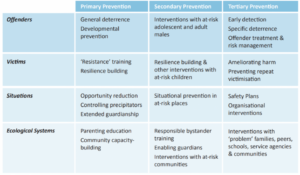Prevention
The central aim of the HIPS CSA Strategy is to prevent child sexual abuse (CSA) from occurring in the first place. Nationally, there has been a steep increase in reporting of child sexual abuse to the police over recent years. Over 83,000 child sexual abuse offences (including obscene publications) were recorded by police in the year ending March 2020 – an increase of approximately 267% since 2013. Of these, around 58,000 would be considered contact offences, which have increased by 202% in the same period.
The number of child sexual abuse offenders managed by probation and the police is growing on an annual basis.
There are three stages of prevention (Smallbone et al., 2008):

Reference
Smallbone, S, Marshall, W.L. and Wortlay, R. (2008). Preventing Child Sexual Abuse: Evidence, Policy and Practice. Routledge; 1st edition.
The HIPS CSA Strategy sets out the way in professionals will respond to these three stages of prevention:
- Ensuring that the HIPS workforce and families have an increased awareness and understanding of CSA.
- Exploring ways to support potential offenders by providing resources that will help them avoid acting on thoughts of CSA.
- Ensure that it remains part of the curriculum delivered in schools and community settings so that children and young people understand what CSA is, understand the meaning of consent and how it should be sought, and how they may be targeted.
- Ensure that healthy and unhealthy relationships (including CSA), consent and sex are part of a wider high-quality relationships and sex education curriculum delivered in schools and community youth settings.
- Create safer public environments for children and young people. Check regularly on places where young people are known to spend time and ensure they have good lighting and CCTV.
- Support professionals to develop confidence in talking to children and young people about sex, relationships and consent on a regular basis and create an open and safe environment where these conversations are normalised.
- Ensure that more people in the community, including potential offenders, those close to them and professionals, will seek advice and information on avoidance and deterrence.
- Highlight and signpost to trusted organisations in the sector focusing on at-risk groups, high-risk online environments, and impactful settings in the local community.
- Advocate for and run campaigns to tell children, parents and wider family about sexual abuse and where they can find support or information if they are worried
- Develop media campaigns to inform a wider audience about CSA, ensuring that this is available in a range of languages and mediums and working to reach those who are rarely in touch with or heard by services. This will include making information available at places like libraries and community events, as well as local newspapers, social media and websites.
- Ensure that agencies work together and share information in a timely way which is key to the effective risk management of child sexual abuse offenders, through processes like multi-agency public protection arrangements (MAPPA).
- Ensure that agencies effectively manage registered sex offenders (RSOs) and the risk they pose to children.
- Ensure that those who have offended are subject to quality risk assessments and risk management plans to mitigate the threat they pose.
- Support law enforcement agencies to become more adept at detecting offending and reoffending, including breaches of notification requirements and civil orders.
- Ensure that the number of civil orders and criminal prosecutions achieved against perpetrators will increase so that future harm is disrupted/prevented.
- Ensure the tools and processes available to law enforcement to effectively manage offenders become more robust and well-evidenced.
- Make potential offenders aware that they will be caught and face serious consequences if they engage in any form of child sexual abuse, whether it is contact or online sexual abuse.
- Deter potential offenders from perpetrating abuse with the right intervention at the right time.
- Ensure strategic support for national and local initiatives to divert people away from offending, through continued investment in these services and clear referral pathways.
